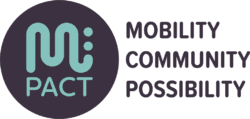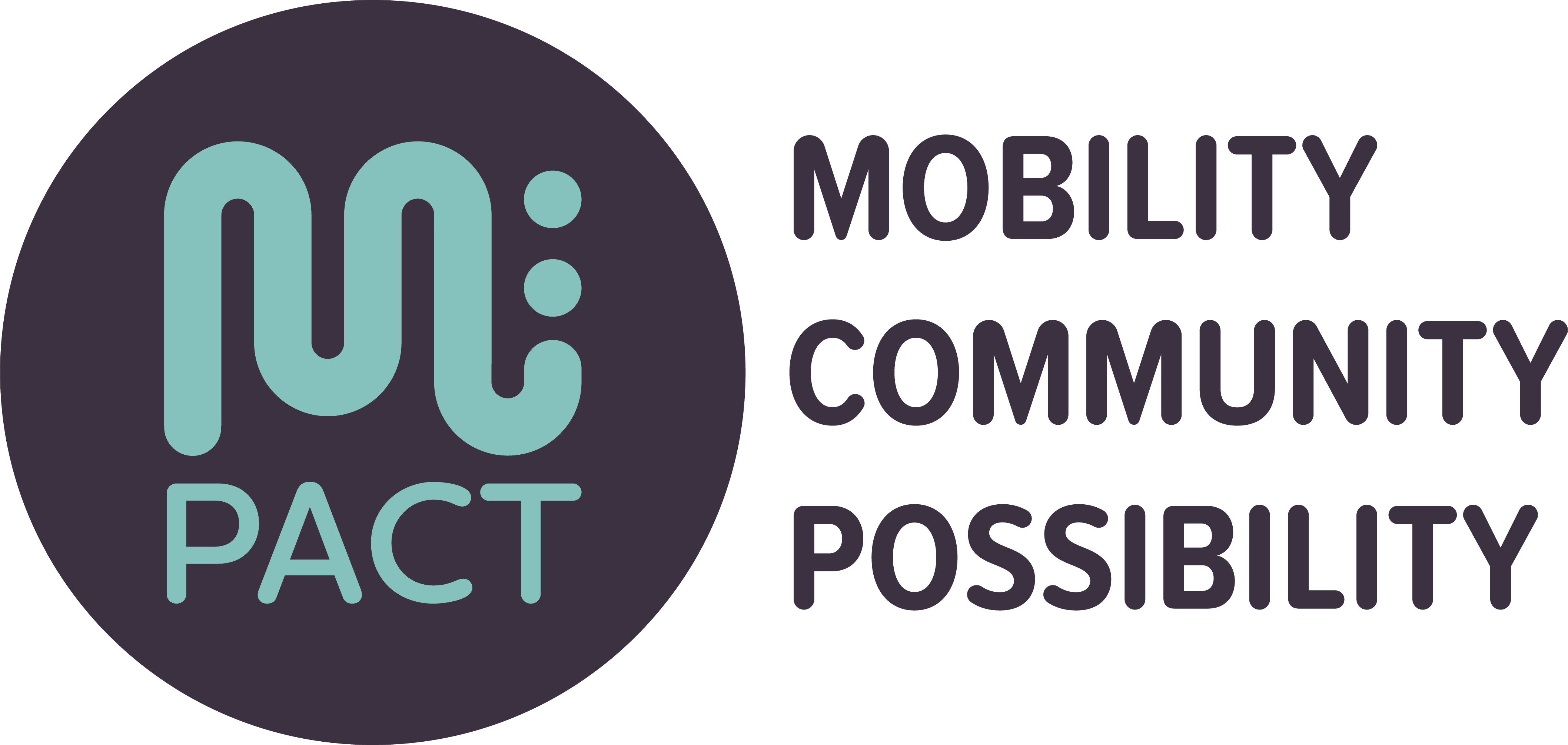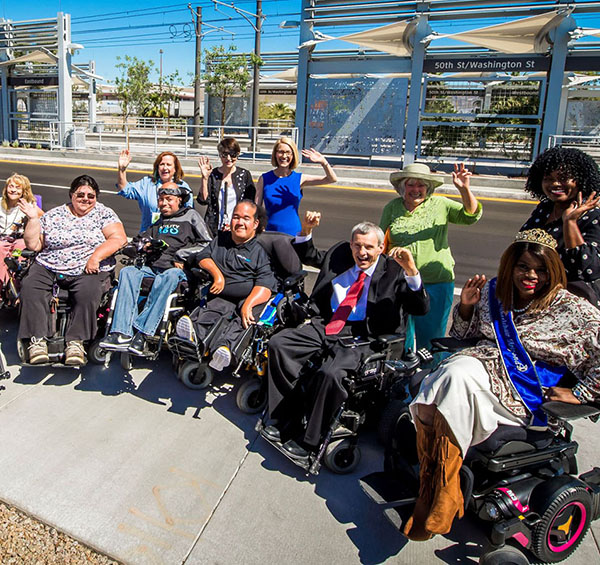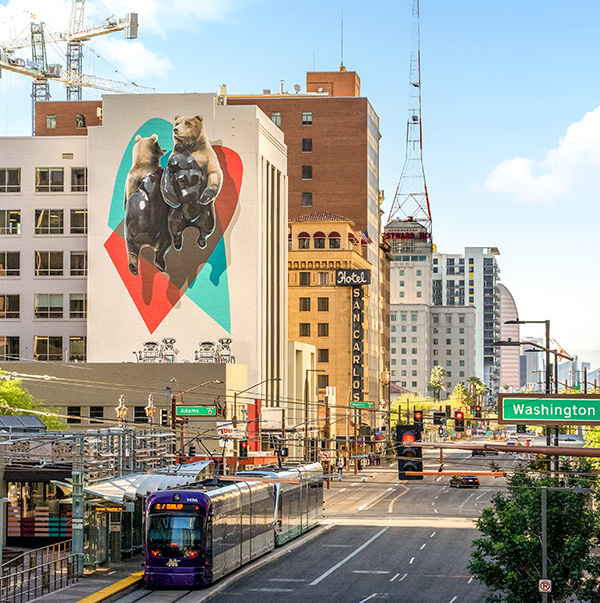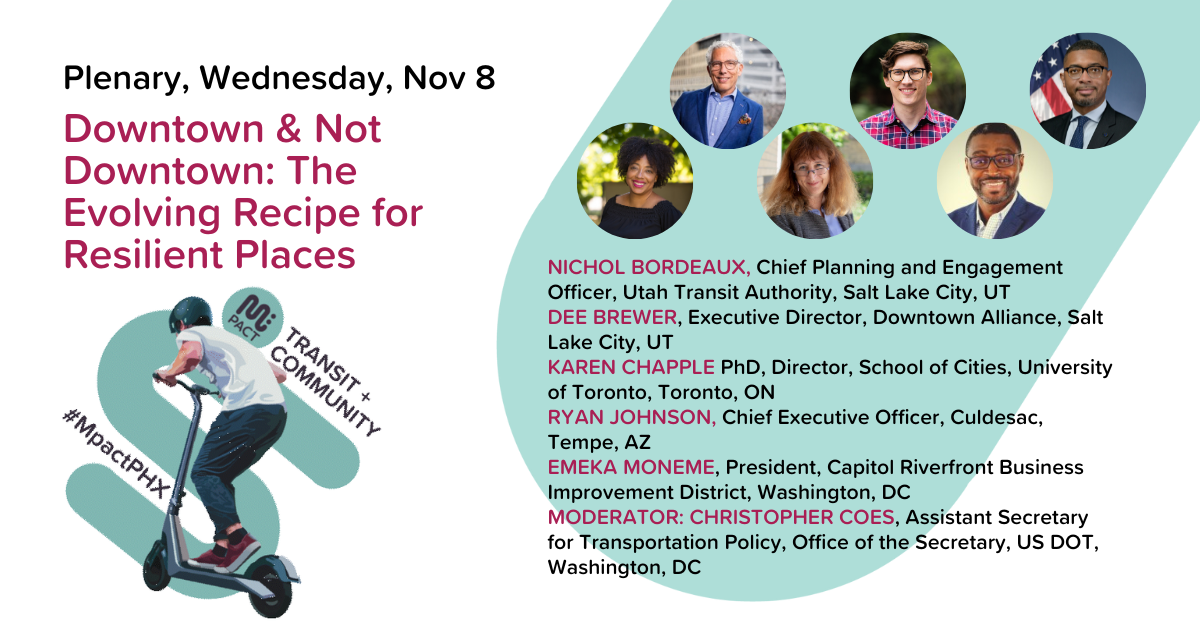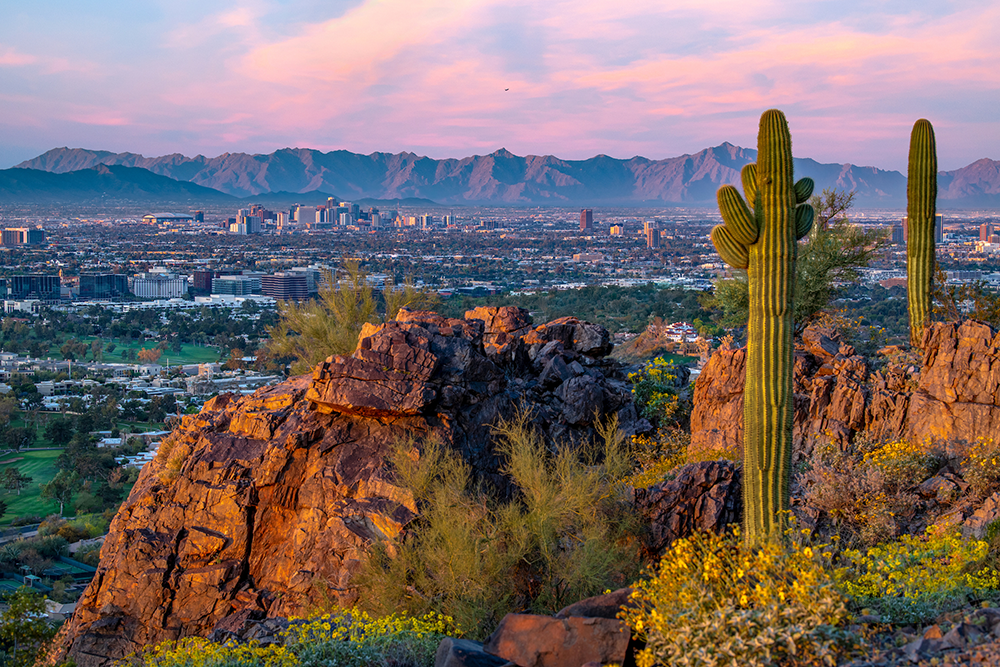Networking
Mpact Innovators Presents: Mpact PK Slam Recovery Run
Meet in Lobby
Join other Mpact Transit + Community runners for a group jog to recover from the PK Slam festivities. Plenty of options to fit your pace.
Mobile Workshop
MW22 50th Street Station: Innovating for Accessibility
$45
A perfect alignment of funding, vision and design came together for the 50th Street Station on the Valley Metro light rail system, a stop that was added more than 10 years after operations began. Learn the fascinating story of adding a station into existing right-of-way without losing travel lanes for autos. You’ll also learn how the station was designed with unique and innovative accessibility elements, in partnership with Ability 360, an organization that empowers people with disabilities to lead more independent lifestyles within the community. Hear from all the players involved, including the City of Phoenix, Valley Metro and the design and engineering firms who worked on the station. Bonus: a tour of the amazing Ability 360 campus, which provides training, sports and fitness, a variety of services and mentoring opportunities.
Session
Mobility Hubs: Hype or Substance?
Ahwatukee, 2nd Level
Mobility hubs are a hot concept – seen as a potential solution to multiple challenges, from enhancing the customer experience to extending the agency’s reach to advancing equity. But is this all hype? Or is there something real brewing? Let’s take a look at the evidence from around the country. We’ll share typologies for integrating mobility hubs and transit. And check out an evaluation system that includes such factors as equity, ridership, adjacent land uses and transit levels of service. There are lessons learned from efforts to develop mobility hubs and upgrade passenger facilities, among them the importance of aligning the vision with local government and defining the type of mobility hub based on community context. Get the facts – and tools to make decisions in your community.
Moderator: Javier Paredes, AIA, Principal, Studio Massivo / Board Trustee, VIA Metropolitan Transit Authority, San Antonio, TX
Todd Hemingson, AICP, Senior Transit Consultant, HDR, Inc., Austin, TX
Krute Singa, Principal Regional Planner, Metropolitan Transportation Commission (MTC), San Francisco, CA
Session
Housing Hard-Core: Creative Investments in Transit-Centric Affordability
Laveen 2nd Level
Affordable housing is a lot more complicated than getting people into homes – though that is job #1. Behind the scenes, it’s hard-core work, steeped in details about how investments are devised, how buy-in is created and how a variety of resources are compiled to make affordable housing truly feasible and readily available. Join a fireside chat with two local leaders at the forefront of the intersection of housing and transit. They bring outside-the-box thinking and a track record of finding new methods for putting housing where it belongs: back into communities.
Moderator: Terry Benelli, Executive Director, Local Initiatives Support Corporation (LISC)- Phoenix, Phoenix, AZ
Howard Epstein, Founder, Arizona Housing Fund, Phoenix, AZ
Session
Data Traveler: Worldwide Lessons in Expanding Transit
Maryvale B, 2nd Level
The transportation system is the nervous system of a city. To understand how it works, we need to understand the data it’s giving us – across multiple modes – and then adapt and develop our transit systems to provide what our cities need. Learn from national and international examples and data that demonstrates our changing needs, patterns, habits and what it all means for the planning and development of transit in our cities. Are you interested in using data to develop strategies for building cities and master planning, changing policies and investing more strategically in transit systems? Don’t miss out!
Moderator: Melissa Elefante-DuMond, AICP, Practice Builder, Kimley-Horn and Associates, Inc, Seattle, WA
Federico Messa, Senior Transport Consultant, Fondazione Transform Transport/Systematica, New York City, NY
Rawad Choubassi, Partner, Director, Fondazione Transform Transport/Systematica, Milano, Italia
Aaron Xaevier, Planner III, Valley Metro, Phoenix, AZ
Session
True Accessibility and Universal Design
Estrella, 2nd Level
We have collectively spent billions on curb cuts, accessible pedestrian signals, elevators, level boarding and other transformative solutions. But for many people with disabilities, a big remaining barrier is navigating to and within the pedestrian environment – locating the transit stop, finding the escalator, using the kiosk or boarding the right train. Knowing how to start moving or when you’ve arrived can be the difference between comfortably navigating a complex transit area or staying home or getting stuck on more costly and less desirable paratransit. There are new wayfinding technologies in the tool box. Let’s explore their advantages and financial implications along with strategies for addressing challenges such as a digital divide that could dictate who has access.
Ron Brooks, Founder / Chief Executive Officer, Accessible Avenue, Phoenix, AZ
Sarine Sahakian, Senior Urban Designer & Project Manager, evolve environment::architecture, Pittsburgh, PA
ADA, Design, Technology.
Session
FTA TOD Planning Grant: Roundtable Discussion
Maryvale A, 2nd Level
When it comes to grants, are you putting your best foot forward? Let’s get together — roundtable style — for a peer-to-peer discussion on the the FTA TOD Planning Grant process. We’ll cover the application, administration and implementation process, along with the challenges and opportunities you’ll encounter at each stage. If you’re a first time applicant or an award newbie, this discussion is especially for you!
Moderator: Derek Hull, Director, Policy Planning, Metropolitan Atlanta Rapid Transit Authority (MARTA), Atlanta, GA
Michael Swan, Principal Planner, New Jersey Transit (NJ Transit), Newark, NJ
April McLean-McCoy, Community Planner, Federal Transit Administration, Washington, DC
Federal Funding, Planning, Capacity Building, Transit-Oriented Development (TOD).
Session
Infrastructure Projects and Tribal Lands
Cave Creek, 3rd Level
Infrastructure projects are always complex. And yet they happen within a fairly formulaic structure and sequence. How does this work when projects traverse and are meant to serve Native American communities and reservations? All too often, processes can neglect the sovereignty, cultural traditions, treaty rights and values of Tribes. Learn ways to work with Tribes that facilitate respectful and meaningful dialogue with Tribal governments and that are outside the typical role as stakeholder. Let’s talk about consultation, negotiation and joint planning between agencies and Tribes.
Andrew Strobel, Director of Planning and Land Use, Puyallup Tribe of Indians, Fife, WA
Mobile Workshop
MW23 Evolving Downtown Phoenix: Business District to Neighborhood
$45
From a sleepy central business district to a thriving nexus of arts, culture and innovation, Downtown Phoenix continues to defy the odds. Go behind the scenes to learn about the public-private partnerships helping to usher Downtown Phoenix into its newest evolution: a walkable urban neighborhood. Take a look at the streetscape enhancements, sidewalk improvements (including a scramble crossing) and tree plantings designed to make a more inviting bicycling and pedestrian experience and accommodate express buses. Hear about the new developments and sustainability programs that helped pave the way for transformational residential growth and a flourishing nighttime economy.
Session
Flex Your BRT Muscles to Boost Your Corridor
Laveen, 2nd Level
Communities of all sizes are planning, designing and building Bus Rapid Transit. Let’s dig into a couple of exciting and transformational case studies from Denver and Houston for specifics about flexing the mode to meet local needs – for high-quality transit, safer streets, more vital business districts and access to parks and public amenities. Find out how BRT projects can foster strong coalitions via community-centered planning and design. Get details about what it means to consider the needs of a range of stakeholders– specific communities, businesses, vulnerable travelers. Learn about options for delivering access, safety, placemaking and street and station design, as well as the tradeoffs involved. BRT is a flexible mode; it’s all about how you flex it!
Moderator: Thomas Brennan, Director of Business Strategy, Nelson\Nygaard Consulting Associates, Inc., Portland, OR
Adam Borsch, Multi-Modal Planner/Engineer, Parsons Corporation, Denver, CO
Amma Cobbinah, Senior Planning Program Manager, Metropolitan Transit Authority of Harris County (METRO), Houston, TX
Timothy Reynolds, AICP, Vice President, Transit & Rail, WSP USA, Cincinnati, OH
Businesses, Design, Community Engagement, Bus Rapid Transit (BRT).
Session
ETOD: Centering Community Vision and Power
Ahwatukee, 2nd Level
Building power with communities is vital to envisioning more equitable transportation investments. So, let’s have a powerful discussion on the topic. Break into small groups and reflect on the role community visioning plays in the local planning context. How are you moving from community-engaged to community-led planning? How are public, private and community-based planning efforts in your region leading with vision? What’s working and what’s hard? This is an opportunity to share stories from your own experience, hear from others and share resources for participatory planning.
Leah Jaramillo, IAP2, National Public Engagement Group Lead, David Evans and Associates, Inc, South Jordan, UT
Eva Olivas, Executive Director/Chief Executive Officer, Phoenix Revitalization Corporation, Phoenix, AZ
Joél Carrasco, AICP, City Planner, City of Phoenix, Arizona, Phoenix, AZ
Giulia Pasciuto, Strategic Advisor, City of Seattle, Seattle, WA
Abdi Yussef, Equitable Development Organizer, Puget Sound Sage, Seattle, WA
Session
Doing It for the Neighborhood: Community-Centered Economic Inclusion
Cave Creek,3rd Level
Community development corporations (CDCs) are neighborhood-level nonprofit organizations created to support and revitalize communities. To find out what this means on the ground, dive into a case study of the Retail, Arts, Innovation and Livability (RAIL) CDC in Mesa, Arizona. Small business support and economic capacity-building are core to their work, but not all. Their ethos “Do It for the Neighborhood,” involves a comprehensive, place-based approach to neighborhood preservation and wealth-building. Hear about their strategies for building family income and initiatives focused on creative placemaking, heat mitigation and housing justice. It’s all in the name of having transit-oriented communities that work for – rather than displace – vulnerable populations.
Moderator: David Longoria, Program Officer, Local Initiatives Support Corporation (LISC)- Phoenix, Phoenix, AZ
Ryan Winkle, Executive Director, Retail, Arts, Innovation & Livability Community Development Corporation (RAIL CDC), Mesa, AZ
Augie Gastelum, Founder, Patchwork Community Inclusion, Phoenix, AZ
Jennifer Gastelum, Art Engagement / Placemaking Leader, Creative Community, Phoenix, AZ
Businesses, Housing, Community Development, Capacity Building, Placemaking.
Session
Big Data So What? Let’s Get Somewhere
Estrella, 2nd Level
Too many numbers can make us numb. Our ability to collect large amounts of data often outstrips the ability to analyze it or take action based on findings. There also are challenges of determining how much data to collect, how granular it should be, how to store it and how to set up systems to process it. Hear from transit agencies that have leveraged big data to inform decisions that empower staff across the agency. Learn how they’ve used data to identify long-term trends, track key metrics and identify root causes of changes in performance. Also hear about realtime solutions to reducing traffic incidents and how big data can guide decision-making about equitable transit-oriented development (TOD). Let’s take the numbers and get somewhere!
Moderator: Courtney Sung, Director of Strategy and Business Development, Via Transportation, San Francisco, CA
Jeff Wilkerson, Senior GIS Administrator, Valley Metro, Phoenix, AZ
Hazel Scher, Senior Account Executive, Swiftly, Los Angeles, LA
Session
Navigating Transit’s Fiscal Cliff
Maryvale B, 2nd Level
Transit agencies across the country — particularly those reliant on farebox revenue — face an oncoming crisis as COVID relief operating funds will run out over the next few years. Ridership is still on a slow path to recovery, while inflation and workforce challenges are putting significant strain on the cost side. Mitigating risk starts by understanding the problem, evaluating funding options and engaging and convincing stakeholders. Let’s walk through the steps, with case studies from agencies already doing this work. Because smart planning can help ensure a fiscal cliff doesn’t turn into a budget catastrophe.
Moderator: Maggie Schilling, Director, Policy Review and Development, Federal Transit Administration, US Department of Transportation, Washington, DC
David Baumgartner, Senior Associate, Cambridge Systematics, Inc., Medford, MA
Peter Kersten, Program Manager, Strategic Plan Implementation, Regional Transportation Authority -Chicago, Chicago, IL
Session
Transit + Mega Events: A Winning Team
Maryvale A, 2nd Level
Whether it’s the World Cup, Super Bowl, Olympics, a political march or sold-out concert, transit can be a key differentiator in a successful mega event. Join experienced transit experts for a discussion around operations, security, marketing, partnerships and community engagement. Even if you’re from a smaller city, we’ll cover best practices that could come in handy next time a big crowd comes to town.
Moderator: Allan Gooch, Managing Director, Allan Gooch Limited, London, UK
Susan Tierney, Communications Manager, Valley Metro, Phoenix, AZ
Elizabeth Vieweg, Director / Senior Practice Lead, Operations Management, Arcadis IBI Group, Toronto, ON
Andrea Lendak, Director, Arcadis IBI Group, Toronto, ON
Rob Rosenberg, Deputy Director Maintenance & State of Good Repair, Valley Metro, Phoenix, AZ
Downtowns, Economic Development, Communications, Community Engagement.
Plenaries
Closing Plenary Lunch – Downtown and Not Downtown: The Evolving Recipe for Resilient Places
Phoenix Ballroom, 3rd Level
Welcome – Christopher Coes, Assistant Secretary for Transportation Policy, Office of the Secretary, USDOT, Washington, DC
Plenary – Downtown and Not Downtown: The Evolving Recipe for Resilient Places
Why are some downtowns bouncing back more than others? What neighborhoods or places, downtown or not, are thriving – and why?
Researchers typically measure downtown vitality via three key indicators: office vacancy rates, public transit ridership and retail spending. But the underlying assumptions behind those data points – that people work downtown, transit is designed to take them there and downtown workers drive retail – are up for grabs. After the pandemic lockdowns of March 2020, some workers discovered they could take their jobs to cheaper places to live – or just save the time and money of a commute. And those that can still are, upending the downtown equation, perhaps especially in places with high housing costs. More than six months after US and global agencies announced the end of the pandemic, why are some downtowns bouncing back more than others? What neighborhoods, downtown or not, are thriving – and why? Let’s look at what new data points and models can show us, with top experts and practitioners involved in downtown and non-downtown centers. What have we learned from the systemic shock of the past three years? What are we learning today from the disruptions caused by extreme weather events around the country and globe? How can decision-makers use these lessons to foster more resilient, transit-oriented downtowns and neighborhoods ready to weather the next (literal or figurative) storm?
Karen Chapple, Ph.D., Director, School of Cities, University of Toronto / Professor, Department of Geography & Planning, University of Toronto, Toronto, ON
Nichol Bourdeaux, Chief Planning and Engagement Officer, Utah Transit Authority, Salt Lake City, UT
Dee Brewer, Executive Director, Downtown Alliance, Salt Lake City, UT
Emeke Moneme, President, Capitol Riverfront, Washington, DC
Ryan Johnson, Co-Founder and Chief Executive Officer, Culdesac, Tempe, AZ
Moderator: Christopher Coes, Assistant Secretary for Transportation Policy, Office of the Secretary, USDOT, Washington, DC
Regional Day
Regional Day: Continuing Our MOMENTUM
Encanto A & B
Forum 2:00 pm – 4:30 pm
Networking 4:30 pm – 5:30 pm
Regional day programming provides an opportunity for the local region to delve into issues that specifically affect them. Local conversations and local solutions. Open to the public.
Register here – select Regional Day Only
$25 – but (hurry!) the first 100 to register are FREE. Use the code RD23FREE when you register!
With a growing population nearing five million residents, the greater Phoenix region is larger than half the states in the U.S. It also located in some of the most unique environmentally and culturally sensitive geography in the country. The region, through the Maricopa Association of Governments (MAG), has invested more than three years developing MOMENTUM, a plan for the future of transportation to support continued economic development and growth. How do we tell our story, articulate our past, fashion our future, and build on the momentum that brought us this far? Hear from local experts, learn from those in the trenches, and listen to visionaries. Take part in activities that will help the region build towards the type of communities we want for ourselves and for future generations.
2:00 p.m. Welcome & Keynote Speakers
- Ed Zuercher, Executive Director, Maricopa Association of Governments, Phoenix, AZ
- Marty Shultz, Vice President, Public and Government Affairs, Pinnacle West & Arizona Public Service (Retired), Phoenix, AZ
- Ryan Johnson, Co-founder and Chief Executive Officer, Culdesac, Tempe, AZ
3:00 pm Panel discussion: How we tell our story
- Tara Jones, Communications Manager, AECOM, Atlanta, GA
- Jerome Gray, Executive Vice President & Chief Communications Officer Metropolitan Transit Authority of Harris County, Houston, TX
3:45 pm – 4:05 pm Breakout Round Table Discussion: What stories do we want to be told?
Join table conversations led by people representing different areas of concern around mobility, access and wellbeing. Identify one or two key storytelling messages critical for the future of the Valley.
4:05 pm Report Out & Closing Remarks
4:30 pm – 5:30 pm Networking Event
